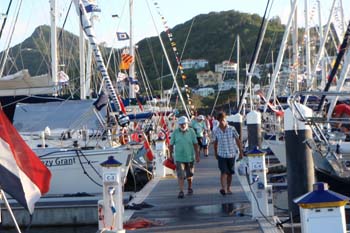This has been one of the fastest ARCs on record but abandonments have raised wider seamanship issues
This weekend the last of the 209 yachts taking part in the ARC finished in St Lucia, capping a vintage transatlantic rally. It has been of the fastest ARCs on record, with most boats finishing three days faster than on average.
The ARC fleet was treated to consistent tradewind strength winds the whole way across and was given an unusual boost by strong downwind conditions in the first five days out from Las Palmas. That is very unusual in November, when the Trades are not well established.
One way of telling how much light airs any particular ARC year has had is to look at the motoring hours declared in the cruising class. This year most arrived with little or no motoring hours logged.
Despite the winds, the ARC course record of 11 days 5 hours did not fall. One of the reasons, I think, was that the fastest boat on paper, Bagheera, a Wally 80, sailed a very long course. Taking deep gybing angles (and long gybes) teased their distance sailed out to a whopping 3,400 miles, or 25 per cent longer than the rhumb line distance.
That caused them to miss the record by 13 hours.
But Bagheera’s crew had only sailed the boat for a handful of days before the start of the ARC. The boat had been launched a mere three weeks beforehand. Her crew was an assortment of professionals plus the skipper and engineer from the owner Kemal Cingillogle’s father’s motorboat.
The 24-year-old Turkish owner was himself new to sailing and had never been offshore before the ARC. He was given Bagheera as a graduation present, having spotted another Wally 80 at a regatta and taken a fancy to it.
The most impressive crossing times were, however, notched up by the smaller boats. For me, the most remarkable crossing time of all was made by the Chapdelaine family from France. Laurent Chapdelaine, his wife Guylaine, 11-year-old son Théo and a family friend sailed their 35ft Maxi 1100 Minimaxi across in 15 days 20 hours.
This is a fantastic time, especially by a family crew. Their secret weapon, they said, was a small, flat-cut heavyweight ‘storm’ spinnaker made for them by North Sails which they flew 60% of the time.
This ARC was characterised by a lot of sail damage, a few broken booms, some rigging failures and a fair few broken spinnaker poles as crews pushed it too far or weary gear gave in.
The event will also be remembered for two abandonments early on. A 53-footer was left after her rudder broke and later salvaged in an operation organised by insurers Pantaenius. A second boat found a stranded inner forestay and lower and her crew elected to be evacuated by a ship west of the Cape Verdes.
This raises some important and wider reaching questions about how crews could be better prepared for what are relatively commonplace emergencies at sea (there are rigging problems and rudder failures in every ARC) and whether, in general, our training courses and seamanship qualifications properly address these issues.
There were two seminars in Las Palmas for ARC sailors that specifically addressed emergencies, including a discussion on how to make jury rudders and rigging repairs from a round the world skipper who had used them in anger.
Information is there for the taking. Yet I know that at least one of the skippers who abandoned his boat didn’t go to this seminar.
I’ll be writing about this in the March issue and would really like to hear your views on if and how sailors could become more self-reliant.
Do you think the RYA Yachtmaster and other qualifications should include emergency repairs as key aspects of seamanship? How do you think people should prepare themselves (and their crew) for efforts to save their boat when things go wrong?
Or do you think the issue is one of expectation and how could crews be more prepared psychologically?




